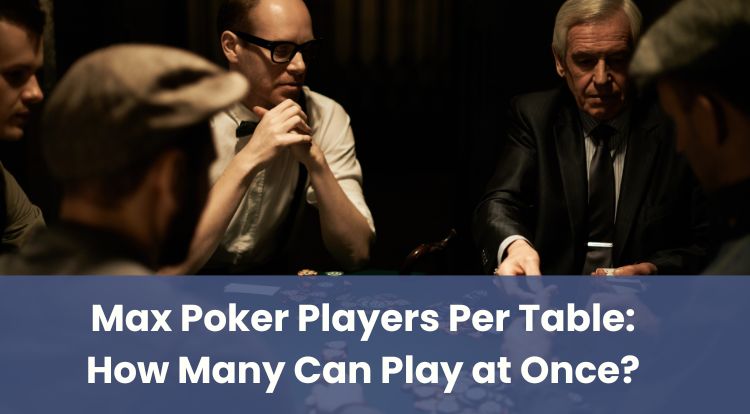
If you have ever thought about joining a poker table, either online or in a real setting, you might be curious about how many people can actually take a seat and play at the same time. The answer changes with the game format and the venue.
Knowing the seat count could help you understand the pace of play, how decisions unfold, and what the overall experience will feel like. Whether you are at home with friends, in a casino, or playing online, there are common ranges that might be worth knowing. Read on to learn more.
How Many Players Can Sit at a Poker Table?
How many people can sit at a poker table depends on the format and where you are playing. In most live casinos, a standard table seats up to nine or ten players, although house rules and particular variants can trim or add a seat.
Smaller set‑ups are common too. Private games and compact poker rooms sometimes run five to seven seats, and some home games use very small tables with two, three, or four players.
Online poker rooms offer the widest choice. You will see “heads‑up” for two players, “six‑max” for six, and “full ring” with nine or ten. Platforms label these clearly in the lobby along with stakes and buy‑ins. Sites regulated by the UK Gambling Commission (UKGC) must display the key details for each game, including the number of seats.
Changing the table size alters the rhythm of play and how participants approach hands.
If you decide to try your hand around the poker table, remember to do so responsibly and within your means; never wager more than you can afford to lose.
Max Poker Players: What's the Max Number Per Table?
The typical maximum at a traditional poker table is nine or ten players, which gives everyone a seat around the layout and leaves space for the dealer.
There are plenty of exceptions by design. Tournaments often run short‑handed tables during certain stages or when the field is being balanced, and many cash games offer options ranging from two seats up to the full allocation. Private groups also set their own caps to suit the space and the format.
Online maximums usually mirror live poker, with some rooms preferring nine seats for full‑ring games and others offering ten. At the other end of the scale, two‑player and six‑seat options are widely available. Lobbies show the maximum before you join, so you know exactly what you are stepping into.
Why Does the Number of Players Matter?
Table size affects tempo, decision pressure, and the types of pots you see. With fewer players, blinds come round more often, so participants are involved in more hands and face choices sooner. Ranges typically widen, pots are often contested heads‑up, and post‑flop situations arrive quickly. With a full table, there is more waiting between hands, more multi‑way pots, and greater emphasis on position and selective starting hands.
The knock‑on effects are easy to feel at the table. Short‑handed games tend to move briskly, so concentration and quick judgement are important. Full‑ring games offer more time between decisions, but each choice can carry more weight because someone else is more likely to hold a strong hand. Pot sizes can also shift with table size. Larger groups can produce bigger average pots, while smaller games often see more frequent but more modest pots.
Comfort matters as much as strategy. It could be a good idea to choose a table size that suits how you like to play and how much attention you want to give. Consider setting personal limits, keep track of your spend, and take breaks when needed.
Typical Table Sizes in Online Poker Rooms
Online poker rooms commonly use three labels for seat counts. Heads‑up tables have two seats and create constant involvement, as every hand includes both players. Six‑max tables seat six and are popular because the action moves quickly without being relentless. Full‑ring tables offer nine or ten seats and a steadier pace with more people in each pot.
Some platforms also add three, four, or five‑seat options for particular formats, along with fast‑fold variants where players move to a new table after folding. Multi‑table tournaments usually aim for a full‑ring layout and automatically balance player numbers across tables as entries rise or fall.
You can see the seat count for any table in the game lobby, alongside stakes, buy‑ins, and game type. If in doubt, the label might give a good sense of how often you will act and what the flow will feel like.
Live Poker vs Online Poker Table Limits
Live poker tables are constrained by the physical space, which is why you usually see nine or ten seats in a casino. Floor staff manage seating lists and, in tournaments, move players to keep tables balanced. Apart from special events or a room choosing to run short‑handed, limits do not tend to change once a table is in play.
Online rooms have more flexibility. Operators can offer a broad mix of table sizes, open or close tables according to demand, and run private tables for groups. Fast‑fold formats keep the seat count the same but rotate the pool of opponents after each fold, which changes the feel without altering the limit itself.
Whichever environment you choose, knowing the maximum seats and the typical table sizes helps you pick a game that matches your pace, budget, and style. It could be a good idea to check the table information, choose the format that suits you, and you will know exactly what to expect when you sit down.
**The information provided in this blog is intended for educational purposes and should not be construed as betting advice or a guarantee of success. Always gamble responsibly.
*All values (Bet Levels, Maximum Wins etc.) mentioned in relation to these games are subject to change at any time. Game features mentioned may not be available in some jurisdictions.
